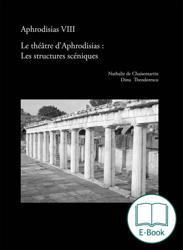The book is dedicated to the Theatre building at Aphrodisias and in particular its stage building. Dated by its two inscriptions between 30 and 27 BC, the theatre’s original stage building stood until its collapse in the seventh century and almost all of the elements of the stage façade were conserved by its transformation into a Byzantine fort. The volume presents a restoration made from long years of study of the architectural elements. The study is of value to architectural development in the Greco-Roman world and reflects patterns in urban development from the Hellenistic to the Byzantine periods.
The book is the full publication of the stage structures of the theatre in the Carian city of Aphrodisias. Dedicated by C. Julius Zoilos, freedman of Octavian, between 30 and 27 BC, the theatre’s original stage building was preserved unmodified until its collapse in the seventh century. Almost all of the elements of the stage façade were buried under a Byzantine fort and the modern village of Geyre, until the excavations of Prof. K.Erim in 1964-1971. No other theatre stage façade of the first century BC is preserved in the Mediterranean world. The book begins with an architectural analysis of the theatre’s main structures: a semicircular auditorium, divided into 11 cunei, an arena surrounded by a podium, a marble-paved stage floor resting on a pulpitum-wall and a rectangular stage building fronted in the west by a Doric portico. In 1988 and 1989 several sondages around the stage building and in the arena confirmed the chronology of the monument’s phases which J.M. Reynolds had established on the basis of epigraphic evidence. In the middle imperial period, the theatre was progressively transformed to accommodate gladiatorial games and wild beast hunts. The recording of all the architectural elements permitted a full restoration of the stage façade, its innovative design, and its original decoration. Contemporary with the treatise of Vitruvius, the Aphrodisias theatre allows a more precise evaluation of the relationship between Greek and Roman theatre designs.
Nathalie de Chaisemartin
1969 Master of arts in Archeology of the Roman World, Paris -Sorbonne University.
PhD of classical Archaeology
1970-1986 Lecturer and assistant professor for french Litterature, civilisation and History of Art
1987- 1999: Assistant-professor in classical Archaeology and History of Art of the Antiquity, Michel de Montaigne- Bordeaux III University
1999 -2012: Assistant-professor in classical Archaeology and History of Art of the roman world, Paris-Sorbonne University,
The series is dedicated to the publication of archaeological research at the ancient site of Aphrodisias. Aphrodisias was a prosperous city of the Roman period, well known for its cult of Aphrodite and its marble-carvers, and it has remarkably preserved remains from the second century BC to the sixth century AD. The archaeology of the city is especially well-suited to the study of public art and monuments in their ancient contexts and to the investigation of the elaborate architectural mise-en-scène of urban political life in the Eastern Roman empire.


 Vorwort
Vorwort